
Related
Guests
- Sonia "Sunny" Jacobswas sentenced to death at the age of 28 for the murder of two police officers in Florida. When she was imprisoned, her two young children were cast into the foster care system. Nearly 17 years after her arrest, Sunny’s conviction was overturned on appeal. Her story, along with those of five other wrongfully convicted death row inmates, became The Exonerated, a play put on by the nonprofit theater, The Culture Project. Sunny is the author of Stolen Time: One Woman’s Inspiring Story as an Innocent Condemned to Death.
- Peter Pringlewas accused of being one of three men who had murdered two police officers following a bank robbery in Ireland. After his conviction, he had been sentenced to be hanged. Just days before a noose was tied around his neck, Pringle learned that Ireland’s president had commuted his sentence to 40 years without parole. Pringle then immersed himself into legal books and effectively became a “jailhouse lawyer.” Serving as his own counsel, Pringle successfully pleaded his case, leading the Court of Criminal Appeal to quash his conviction. He is a human rights and anti-death penalty activist.
Sonia Jacobs and Peter Pringle each served years on death row—Jacobs here in the United States and Pringle in Ireland. Both were exonerated after their convictions were overturned for murders that they steadfastly maintained they did not commit. They began dating shortly after meeting while both publicly campaigning against the death penalty. Their wedding earlier this month was perhaps the first of its kind: the union of two exonerated death row inmates. Joining us from their home in Ireland, Sunny Jacobs and Peter Pringle recount their remarkable story from death row to the wedding altar.
[includes rush transcript]
Transcript
NERMEEN SHAIKH: Oregon Governor John Kitzhaber announced yesterday that he would halt all executions in the state during his time in office. He said, quote, “I refuse to be part of this compromised and inequitable system any longer.” Kitzhaber, a physician, noted that he had allowed two previous executions to go forward under his watch but had since agonized over the decisions.
GOV. JOHN KITZHABER: Those were the most agonizing and difficult decisions I have ever made as governor, and I have revisited and questioned them over and over again for the past 14 years. I do not believe those executions made us safer. Certainly, I don’t believe they made us more noble as a society. And I simply cannot participate once again in something that I believe to be morally wrong.
NERMEEN SHAIKH: That was Oregon Governor Kitzhaber. In all, 34 states still allow the death penalty, but only 27 have executed someone in the past decade, according to the Death Penalty Information Center.
AMY GOODMAN: In an oddly related story, I was reading the marriage section of the New York Times this past weekend, and I saw a piece about the wedding of a couple in Manhattan earlier this month: Peter Pringle and Sonia Jacobs. Their photograph wasn’t that unusual. Perhaps they were older than most newlyweds. Sunny was 64, Peter, 73. But it was the story of their lives and their coming together that we will spend the rest of our show on today. Both Sunny and Peter have survived the death penalty. They survived death row and have been exonerated since. Sonia Jacobs and Peter Pringle.
NERMEEN SHAIKH: Sonia Jacobs and Peter Pringle each served a decade and a half on death row—Jacobs here in the United States, Pringle in Ireland. Both gained freedom after their convictions were overturned for murders that they steadfastly maintained they did not commit. The two would both become passionate anti-death penalty activists, and their activism brought them together.
AMY GOODMAN: Peter Pringle was accused of participating in a murder of two police officers following a bank robbery in Ireland. After his conviction, he was sentenced to death by hanging. Just days before a noose was to be tied around his neck, Peter learned that Ireland’s president had commuted his sentence to 40 years without parole. He then immersed himself in legal texts and effectively became a jailhouse lawyer. Serving as his own counsel, he eventually convinced the Court of Criminal Appeal to quash his conviction.
NERMEEN SHAIKH: Sonia, known as Sunny, was sentenced to death along with her then-husband at the age of 28 for the alleged murder of two police officers in Florida. Her two young children were cast into the foster care system. Although the two maintained their innocence, it was after her husband was executed and another man confessed to the murder that she was exonerated. Nearly 17 years after her arrest, Sunny’s conviction was overturned on appeal.
She is the author of Stolen Time: One Woman’s Inspiring Story as an Innocent Condemned to Death. Sunny’s story, along with those of five other wrongfully convicted death row inmates, became The Exonerated. Sunny has been portrayed by 28 actresses, including Mia Farrow, Brooke Shields, Amy Irving and Susan Sarandon, some of whom attended her wedding. This is Susan Sarandon playing Sunny in The Exonerated, reflecting on the murder charges leveled against her.
SUSAN SARANDON: [playing Sonia Jacobs] My husband Jesse was tried first. He had a past record from when he was 17 years old, and his trial lasted four days. We both had, of course, no good attorneys, no dream team, no expert witnesses. And so he was convicted and sentenced to death. My trial came later, and I thought, well, surely, that won’t happen to me. I mean, I was a hippie. I’m one of those peace and love people. I’m a vegetarian. How could you possibly think that I would kill someone? And so, I thought that I’d just—I’d go in, and they’d figure out I didn’t kill anyone, and they’d let it go. But that’s not how it works.
AMY GOODMAN: That’s Susan Sarandon playing Sonia Jacobs in the play The Exonerated, put on by The Culture Project here in New York.
Well, Sunny and Peter have since spoken in schools, churches, other venues across the country and the world on human rights and abolishing the death penalty. Their wedding earlier this month was perhaps the first of its kind: the union of two exonerated death row prisoners. And so we go to Galway right now, to Ireland, to be joined by the newlyweds themselves, the former death row exonerees, modern-day human rights activists, Sunny Jacobs and Peter Pringle.
Sunny and Peter, congratulations on your wedding. Welcome to Democracy Now!
PETER PRINGLE: Thank you.
AMY GOODMAN: We’re going to talk all about your activism today.
SONIA JACOBS: Thank you.
AMY GOODMAN: But I want to start with Sunny. If you wouldn’t mind going back in time and telling your story, how it was you and your husband, since executed, ended up on death row, your first husband.
SONIA JACOBS: Well, briefly, we were in the wrong place at the wrong time with the wrong people. And as a result, we ended up being present when two police officers were killed. And the man who actually did the killing took a plea bargain, which I don’t think should be allowed in capital cases, and testified against us, saying that we did it. He, in turn, was given three life sentences in exchange for his testimony. Jesse’s trial, as you know, took four days, and he was tried, convicted and sentenced to death.
My trial took longer, because I was a young mother of two children and had never been in trouble for anything violent in my life. And aside from his testimony, they also brought in a young woman who had been arrested for a drugs violation. And in order not to go to prison for a long time herself, she also testified. And as a result of that and the judge’s instructions to the jury, my jury voted for conviction. But when it came to the sentencing phase of the trial, my jury actually was not able to be unanimous, because one man held out for his own beliefs rather than giving in to the pressure that was being put upon him to agree, and so my jury voted for life. The judge overruled the jury in my case and voted for—and sentenced me to death anyway.
AMY GOODMAN: And the picture of what happened, the date that it happened, you were all driving in a car—you, your husband Jesse, your two kids, and the driver, who eventually turned out to be the one that confessed? What happened? You were in Florida?
SONIA JACOBS: Correct. Yes, we were in Florida, and we were just getting a lift from one place to the other. And it got late, with visiting here and there, and so we decided to pull off into a rest area on the interstate. And I was asleep in the back with the children when the policemen came to do a routine check of the area, as I now know, and saw a gun between the driver’s feet, opened the door, took the gun, pulled him out, asked for his identification, called it in, and when they found out that he was on parole, that, of course, is a violation of parole, and then the scene turned ugly, and the shooting began. And I ducked down to cover the children. And when I looked up, the policemen were dead, and we were ordered into the police car by the man who had done the killing and driven away. So at that point, we basically had become hostages.
AMY GOODMAN: So, you’re both given life—you’re both sentenced to death, you and Jesse. You’ve lost your children, have no—
SONIA JACOBS: Yes, yes.
AMY GOODMAN: Your children went where?
SONIA JACOBS: Well, at first, my children were held in custody. My daughter was only 10 months old at the time, and my son was nine years old. It took my parents a couple of weeks to get my daughter. But it took two months to get my son, who was being held in the juvenile detention center in isolation because he was so young. And as a result, he was very traumatized. He was actually taken to hearings at night, handcuffed behind his back, without any representation whatsoever, as a nine-year-old boy. And so, when, finally, my parents were able to get a hold of him, because a kindhearted judge ordered him to be released, he developed a speech impediment, and he had to be put in special school. From then on, they lived with my parents for the next six years, until my parents were killed in a plane crash, and then they went into care.
AMY GOODMAN: They went into foster care.
SONIA JACOBS: Yes.
AMY GOODMAN: So you wrote back and forth with your husband, Jesse, as you both sat on death row.
SONIA JACOBS: Yes.
AMY GOODMAN: How long were you both on death row? How long were you in solitary? And then explain what happened to Jesse.
SONIA JACOBS: Well, it’s interesting that you say that, because, you see, the men had a death row. The women didn’t have a death row. At the time that I was convicted, I was the only woman with a sentence of death in the United States, because three years prior, they had stopped sentencing people to death. There was a sort of a moratorium in the United States against using the death penalty. And so, there was actually no one on death row for a while. And then there were men on death row. But as you know, murder is mostly the—a problem of men, not women. Women argue and smack each other, and men kill each other. And so, at the time, there were a few men on death row, where Jesse was sent, but there were no women on death row. And so, I was sent to the maximum security women’s prison in Florida and put into a unit all by myself, and I spent the next five years in solitary confinement.
NERMEEN SHAIKH: Sunny, you also talk about how it is that while you were in prison, you made your cell a kind of sanctuary. Can you talk about how you did that?
SONIA JACOBS: Yes. At first, when I first was sent to—got my death sentence, I couldn’t really process it, because it just was beyond my imagining how it could even happen to me, no less actually be a reality. And so I—my cell was very small. It was six steps from the door until the toilet. And if I reached out my arms to both sides, I could touch the walls. And all there was in the cell was a metal shelf on which there was a thin mattress and a pillow. And then there was the sink and toilet. And that’s all there was. There were no bars. There was a solid metal door. And the guards were under orders not to speak to me.
And so, I just paced back and forth, mostly in anger and confusion—and, truth be known, in fear that they would actually kill me. And I had no communication whatsoever with the outside world at first—no phone calls, no visits. I didn’t get out of my cell. It wasn’t 23 out of 24 hours a day in the cell; it was 24 hours a day in the cell, except for twice a week, when I was taken out for a quick shower, and then I could—I was given some prison clothing and allowed to spend a few moments out in a courtyard with a guard, and then brought back into my cell again. So—
NERMEEN SHAIKH: And during this time, actually, the guards were even forbidden from speaking to you?
SONIA JACOBS: And after a while—and I had no books. Yes, yes, because if they were going to participate in my execution, they couldn’t see me as another human being and sympathize with me. I had to be less than human. And in order to do that, we couldn’t have conversations. And anyway, so I had a Bible and a law book. The law book was useless, because I couldn’t even understand the language. And the Bible, I considered it a book of wisdom at that point of time, because I wasn’t even sure there was a god anymore, because I couldn’t imagine how God could let this happen to me and my whole family, because it doesn’t just happen to one person, it happens to the entire family.
AMY GOODMAN: So—
SONIA JACOBS: And at some point, I—
AMY GOODMAN: So, Sunny, after your—
SONIA JACOBS: I read something in the Bible—
AMY GOODMAN: —your parents—I wanted to ask, after your parents were killed in that Pan Am—
SONIA JACOBS: Oh, I was going to finish answering your question, you see, about how I turned my cell into a sanctuary.
AMY GOODMAN: Go ahead.
SONIA JACOBS: I didn’t mean to take so long to get there, but I read something in the Bible that told me that they don’t say when I die. And it was at that point that I realized that until they do end up taking my life or setting me free, which I thought would be the proper result, my life still belonged to me, and that it would be foolish of me to spend the rest of my life, be it long or be it short, in fear and anger and confusion. So I decided that the cell could become my sanctuary, and instead of sitting there waiting to die, I could use my time to make myself the best person that I could be. And so, that’s how I turned my cell into a sanctuary. And I did yoga and meditation, and I prayed and had my discussion with God. And I ended up, I think, maybe healthier than when I went in, in some ways.
AMY GOODMAN: So, Sunny Jacobs, your parents die in the Pan Am Flight 759 in Kenner, Louisiana. You lose touch with your children, who were then in foster care. You’re writing back and forth with your then-husband Jesse Tafero. And on May 4th, 1990, he was executed. How did you survive after that point? And then talk about how your case turned around.
SONIA JACOBS: Well, I think the worst day of my entire life was when my parents died in the plane crash, because then, not only did my children become orphans again, but I became an orphan, too, and there was no one to look out for me outside. And if you’re in prison, and especially if you’re on death row, you need someone to hang onto you from outside.
The day that Jesse was executed, we were given a 10-minute phone call to say goodbye, and we told each other we loved each other, until the phone went dead. And then the officer that had escorted me to the phone call gave me a few moments to myself, and then I asked if she would bring me back to my cell, and she did. And actually, because Jesse’s execution was so horrible and so gruesome, I think everyone was sympathetic that day. It was just so horrible.
NERMEEN SHAIKH: What happened, actually, Sunny, during his execution?
SONIA JACOBS: Well, you see, when Jesse was put in the electric chair and they pulled the switch, he didn’t die. Instead, his head caught fire. And they say—the witnesses that were there say that a flame shot two feet in the air out of his head, and smoke came out of the helmet. And instead of dying, he struggled against the restraints, and they had to pull the lever three times before he was actually pronounced dead, and that it took 13-and-a-half minutes for Jesse Tafero to die. And the reason was because they had substituted the natural sea sponge in the helmet, which was supposed to conduct the electricity properly. They switched it with—for an artificial sponge, which didn’t conduct the electricity properly, and as a result, he caught fire. As his mother said later, when Sister Helen Prejean escorted her to the church that night, her son was burned at the stake. And it was so horrible that when our daughter, who was then 15-and-a-half years old, heard what happened to her father, she tried to kill herself.
AMY GOODMAN: So it was, what, two years later, in 1992, nearly 17 years after you both were arrested, that the confession of the shooter was made, and you were exonerated, though Jesse was killed?
SONIA JACOBS: Well, yes, about two-and-a-half years after Jesse was executed, with the help of lawyers who worked for free, pro bono, and friends, one of whom you know, my friend Micki Dickoff, who is a documentary filmmaker, because of their efforts, we were able to uncover evidence that had been hidden for all those years, including the fact that the man who actually did the killing had confessed in front of other witnesses. And as a result, I was then released.
AMY GOODMAN: We’re going to break right now. When we come back, we will hear your new husband, your bridegroom’s story, Peter Pringle, and then hear about what the two of you are doing together, as you continue to travel and speak out against the death penalty. Our guests are Sunny Jacobs and Peter Pringle. They are newlyweds, and they are both exonerees, they both survived death row. This is Democracy Now! Back in a minute.
[break]
AMY GOODMAN: Steve Earle singing “Christmas in Washington.” I’m Amy Goodman, with Nermeen Shaikh. Our guests in Ireland are the newlyweds Peter Pringle and Sunny Jacobs. They got married in New York, flew home to Ireland, and are now telling us their story. Steve Earle, who we just played, was instrumental in the two of you coming together. But, Peter, before you tell us about Steve, tell us, if you would, your own story of how you ended up on death row and then free.
PETER PRINGLE: OK. Thank you. Very briefly, on the 7th of July, 1980, there was a bank robbery in a town called Ballaghaderreen in County Roscommon in Ireland, following which the escape car collided with a police car, there was an exchange of gunfire, and two police officers were killed. The raiders separated, split open across country. One man was arrested that evening. Another man was arrested the following morning. And a third man was being pursued across country by the police. I had nothing whatever to do with it. I was in a different county in a different city at the time. The person they were chasing was chased right through the city where I was, which is the city where I am now, Galway, and he eluded them. And so, they arrested me, fabricated evidence against me, and brought me before the Special Criminal Court in Dublin, which is a non-jury, politically established court, where I was convicted and sentenced to death. Upon the word of a police officer that after 43 hours of interrogation, I had uttered these words: “I know that you know I was involved, but on the advice of my solicitor, I am saying nothing, and you will have to prove it all away.” And that is the sole evidence upon which I was convicted and sentenced to death.
I should state that in the 12th day of the—the trial lasted for 34 days, over six weeks, and in the 12th day of the trial, a police officer, who had attempted to arrest the culprit two days after the crime, had actually—was within arm’s reach of him and spoken to him, but he ran away from him and escaped. He gave evidence in the trial, and he was asked, would he—had he seen the man again, and he said he had—in fact, he was in the court. And I was sitting in the dock. And the police officer was asked, could he point out the man. And he pointed up to a man standing in the back row of the public gallery, and he said, “I would say that’s him standing up there with his back to the partition.” And he pointed out a man in the public gallery, at which the people standing beside this man all moved away from him. And he was there standing on his own, like something you’d see in a movie. But he was never stopped. Or he was allowed to leave the court. He wasn’t stopped or charged or anything else. And I was duly convicted, sentenced to death.
I spent six—in Ireland, we didn’t have a death row. I spent six months in the death cell, which would be the equivalent of deathwatch in the United States. And my lawyers made an application for leave to appeal, which put an automatic stay on the execution. And the Court of Criminal Appeal refused that application for leave to appeal and set a new date for execution for the 8th of June, 1981. And about 11 days before that, the president commuted the sentence on the advice of the government, and I was sentenced to 40 years without any possibility of parole. I was put out into the prison population. And I couldn’t possibly face 40 years in prison, and so I determined I would try to prove my innocence. I began to try and study law. And in order to relax so that I would—and ease my anger, my rage at what they had done to me, I began to teach myself the disciplines of yoga and meditation. And it was those two disciplines which brought me through. And when, of course, Sunny and I met, we discovered we had both used the same disciplines, 7,000 miles apart, without even knowing each other. That was another bond we had with each other.
In January of 1992, I eventually opened my case in the High Court in Dublin, being on my own behalf, because I had no money and no lawyers. And I was escorted out from the prison under armed escort and handcuffed, etc., and I opened my case there. And in July of that year, 1992, I won an order for discovery of the police papers in the case. And six months later, when I got some of those documents, I found I was supplied with a copy, a photocopy, of the notebook of the police officer who claimed I had made that statement. And in his notebook, he had written in the alleged statement before his entry for the interrogation in which he claimed I said it. In any event, the case ran from January 1992 through to May 1995. And just before that, before that time in 1994, a human rights lawyer offered me his help, and I took it. And in 1995 in May, the conviction was quashed by the Court of Criminal Appeal. The state asked for a retrial. The court ordered a retrial. I was sent back to the prison on remand. And the following day, I was brought back to the Court of Criminal Appeal, where I was given bail. And a week later, the state dropped the case.
So, consequently, I received no compensation or damages whatsoever. And when I was released on the 17th of May, 1995, out of the Special Criminal Court onto the street, I had no money, I had no identification, no passport, no driving license, no Social Security number, nowhere to live, nothing.
SONIA JACOBS: Same for me.
PETER PRINGLE: Didn’t even get my bus fare. But I had family and I had friends, and they looked after me, and I survived.
NERMEEN SHAIKH: Is it the case, Peter—
PETER PRINGLE: Then, three years—
NERMEEN SHAIKH: —that you were in fact the last person—sorry, Peter, I just wanted to ask you, is it the case that you were the last person who was sentenced to death in Ireland?
PETER PRINGLE: No, that’s not, actually. The media picked that one up. I was one of the last. There were—let me see now. There were one—I think three or four were sentenced to death after me. But all those sentences were commuted, as well.
SONIA JACOBS: But you were the only one who ever got—was released.
PETER PRINGLE: I was the only person in the history of the state who got my conviction quashed, overturned, in a capital case. And I did most of it on my own. And I think I’m probably the only living person in Europe who has had his conviction overturned and released, as an exonerated person from a death sentence.
But three years after I came out of prison, and having gone through the difficulty of settling back into society, which is very, very difficult, I got—I met with Steve Earle. Steve had been communicating with a man on death row in Texas named Jonathan Nobles, who asked Steve to witness his execution, because he wanted one person there who didn’t hate him. So Steve agreed to do that, and was so traumatized by what he saw that he came back to Ireland to chill out a little and recover from that ordeal. While there, I was introduced to him, and we exchanged our stories, we became friends.
Consequently, when Sunny later was on the Journey of Hope, marching against the death penalty through Texas, and an Irish—people from the Irish section of Amnesty International were present and heard her speak, they invited her to come to Ireland the following year to speak at the annual general meeting of the Irish section of Amnesty, which she agreed to. And then, following on that, in Tennessee on another march, she met with Steve and told him she was coming to Ireland. And he said to her, “Oh, you should talk to Peter Pringle.” But he didn’t say why. And when she got to Ireland the next year, and she spoke at a meeting in Dublin, somebody asked her, had she spoken to me. And she said no. And they gave her my number.
So, one day at home, I got a phone call from this American lady, who said to me she wanted to speak to Peter Pringle. I said, “That’s me.” And she said that she was going—she said she was Sunny Jacobs, and she was going to speak at a meeting in Galway the following Friday, and she would—if I wished to come along, I was welcome. So I asked her, “What are we going to speak about?” And she said, “The death penalty.” And I said, “Oh, yeah, I’m interested in that.” Now, at the time, I wondered to myself, now what does this woman know about the death penalty? So I went along anyway the following Friday with two friends. And we were in the venue, which was a room over a pub, at 1:00 in the day, and the people who had traveled with Sunny had gone to get lunch. But we, neither of us, like to eat before we speak about these matters in detail. So I was up in the room waiting for the event to happen, when the door opened to the far side and this little lady walked in. And I walked over to her, and I said, “You must be Sunny Jacobs.”
SONIA JACOBS: And I said, “You must be Peter Pringle.”
PETER PRINGLE: And so, I heard her talk, and I was mesmerized by her story. I was really blown away by the horror of what had happened to her. I knew I had to speak with her again. And I said that to her. But she told me that she had to leave in an hour to go to court with Mary, who is the general secretary of Amnesty. So when she spoke to Mary, Mary was delighted that I was going to take Sunny in charge, and she transferred her back to me. And my friend, a friend of mine in Galway, loaned me his Mercedes car and packed us a lunch, packed lunch. And the following day, I drove her—
SONIA JACOBS: A cheese lunch. We were both vegetarians.
PETER PRINGLE: At the time. And we—I drove her down through Ireland and down to Cork. And as we were sitting in the car, on the car ferry crossing the River Shannon, she turned to me, and she said, “Well, what’s your interest in all this?” And I said—this was the first time she had heard what my story was. And I said to her—I told her that I, too, had been sentenced to death, and I had been exonerated. So she said, “And how did you get through?” And I said, “Yoga and meditation.” And she said, “Wow! Now that’s something,” because that’s what had happened with her.
And so, we traveled on down to Cork together, sharing our story, at times laughing, at times crying, but very, very close with each other. And she spoke at the meeting that evening. And Amnesty booked us into a hotel, two separate rooms. We went over to the hotel, and she came to my room, and we sat down together. And for three hours, we discussed forgiveness. And then she went back to her room. And the following morning, I went off to—back home with the car to return the car. And we kept in communication, long-distance.
And in—after 9/11, we decided that we really had to make a decision whether we were going to live together or not. And, of course, neither of us knew whether we could live with somebody else, because we had been alone and on our own for so long. So we opted for the west coast of Ireland. Sunny reversed what her ancestors did: she packed two big bags, got rid of all her belongings in California, and traveled back east, and came to live with me in a little cottage by the sea on the west coast of Ireland. And we live there now, in a different cottage now, but we still live on the west coast of Ireland, and we have a—we rent a little cottage with three-and-a-half acres. And we have two dogs and two cats and a couple of hens, a couple of ducks, and eight goats, and our garden. We grow our vegetables. We grow our potatoes. We have our eggs from our fowl. And we milk the goats. And Sunny—
SONIA JACOBS: Make cheese.
PETER PRINGLE: —makes wonderful goat cheese. And we try to be as self-sufficient as we can be, because, of course, we have no money. Neither of us got compensation. But we live a very good life there together.
AMY GOODMAN: And yet, you decided to—
PETER PRINGLE: And when we’re not there.
AMY GOODMAN: You got married in New York. You were surrounded by—oh, actually, in your case, Sunny, the women who played you in The Exonerated, like Brooke Shields and Marlo Thomas and Amy Irving. Talk about what you were just saying, Peter, when you are not on the west coast of Ireland, what you’re doing—
PETER PRINGLE: Sure.
AMY GOODMAN: —in these last few minutes that we have.
PETER PRINGLE: Well, what we do is we work with different human rights organizations, like Amnesty, a group in London called Amicus, a wonderful group of people in Italy called the Community of Sant’Egidio.
SONIA JACOBS: The Journey of Hope in America.
PETER PRINGLE: And the Journey of Hope.
SONIA JACOBS: Seeds of Hope in Ireland.
PETER PRINGLE: The Seeds of Hope is an Irish group in Ireland.
SONIA JACOBS: Lots of—
PETER PRINGLE: But the Culture Project in New York was the not-for-profit theater organization that put on The Exonerated. And the Culture Project, we knew that if we—we could get married in New York very easy. And, of course, Sunny is a native of New York, so that kind of was nice to do that. But we couldn’t afford to go to New York. But we got a phone call from the Culture Project inviting us to come to their producers weekend to speak at that weekend and also for Sunny to present awards. So when they heard that we were looking to get married, they said, “Oh, we’ll host your wedding.” And so, that’s what happened. They brought us to New York and put us up and looked after us and hosted our wedding. And that’s how we came to be married in New York.
AMY GOODMAN: We have 30 seconds.
PETER PRINGLE: Now, the—OK, the Culture Project initiated a new award, which they called the Sunny Award. And they’re giving it out every year to people who shed a light on—an artistic light on injustice.
SONIA JACOBS: Yes.
PETER PRINGLE: And Sunny got the first award, and she presented the other ones.
SONIA JACOBS: And if there’s—if I could just say one small thing, it’s that everybody out there can do their part. If you believe something is wrong, then do something about it, whether it’s write a letter, protest with a sign, go down to Wall Street and support them, bring them sandwiches, join an organization. Every person makes a difference. And if you do something about what you believe, then it makes your life and everyone’s life better.
PETER PRINGLE: And if I may make a plug here, we, each of us, have a book written, and we’re ready for any publisher who might be interested.
SONIA JACOBS: We’re ready for the publishers.
AMY GOODMAN: Well, Sunny Jacobs and Peter Pringle—
PETER PRINGLE: And thank you, Amy, for having us on.
AMY GOODMAN: We thank you so much—
SONIA JACOBS: You’ve always been one of my heroes, Amy.
AMY GOODMAN: Thanks so much for joining us from Galway, Ireland. A happy holiday to everyone.

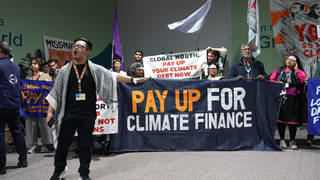
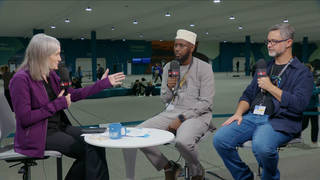
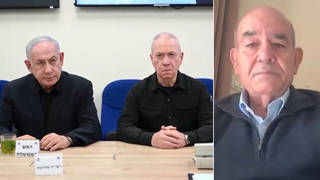
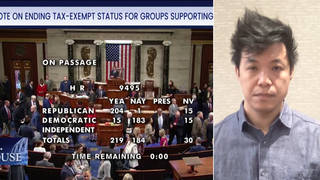
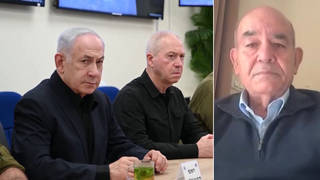




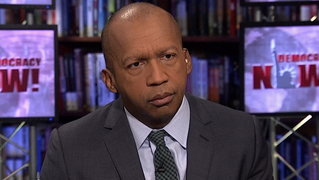

Media Options